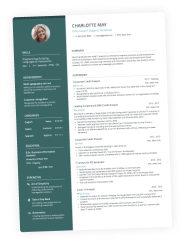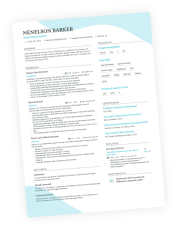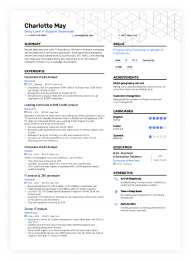Crafting the ideal resume can feel overwhelming—especially when you’re deciding how to present your programming language skills. Recruiters skim for relevance first, then proof. If your languages match the role and you demonstrate impact with them, you’ll make the shortlist.
In this guide, you’ll learn how to choose the most relevant languages, place them for maximum visibility, and prove proficiency with quantified projects, certifications, and links. You’ll also see examples and templates you can adapt in minutes.
Before we dive into the how-to, here are the key points you should keep in mind.
Is your resume good enough?
Drop your resume here or choose a file. PDF & DOCX only. Max 2MB file size.
Choosing relevant programming languages for your resume
Employers’ perception of you starts with the relevance of your stack. If your resume echoes their job post and product ecosystem, you’ll feel “on-spec” at a glance.
Start with the posting and product:
- Scan the job description for explicit languages, frameworks, and databases. If they say “Python, SQL, and Airflow,” those exact words should appear where appropriate.
- Look up the company’s docs, engineering blog, or GitHub to spot the stack in the wild. A React front end on their careers site or posts about Django tells you which way to lean.
- Consider the product domain. Fintech back ends often favor JVM/.NET languages, data teams lean on Python/R/SQL, and high-throughput systems still love C/C++/Rust.
Quality beats quantity:
Listing ten languages reads as shallow. Curate the three to six that you can defend in an interview and that match the role. Add the rest under “Familiar with” or leave them on LinkedIn.
Emerging and in-demand examples:
- Rust for safety/performance in systems, crypto, or tooling.
- Kotlin for modern Android and JVM services.
- TypeScript as the “production-grade” JavaScript for scalable front ends and Node APIs.
Scale matters:
If you’ve shipped large, high-performance systems, naming C++ or Java alongside outcomes (latency cut 30%, throughput +2×) signals you can handle demanding workloads.
Once you’ve narrowed the list, tailor it to the domain and problems you’ll be hired to solve.
Tailoring programming languages to the job and industry
Hiring teams want to see their problems solved in your resume. Mirror the language of the posting and prove you’ve applied it at a relevant scale.
Web/front-end roles
Prioritize JavaScript/TypeScript + React/Next.js or Vue/Nuxt—include CSS-in-JS, testing (Jest, Playwright), and build tools (Vite, Webpack).
Example bullet:
- “Built a TypeScript + React (Next.js) front end; reduced bundle size 28% with code splitting and prefetching.”
Back-end/API roles
Emphasize Java (Spring Boot), C# (.NET), Node.js, Go, or Python (FastAPI, Django) with SQL/NoSQL.
Example bullet:
- “Migrated monolith to Spring Boot microservices; API latency −43%, p95 < 220 ms.”
Data/ML roles
Lead with Python, R, SQL, plus Pandas/NumPy, scikit-learn, PyTorch/TensorFlow, and orchestration (Airflow).
Example bullet:
- “Productionized a Python recommender (scikit-learn); increased click-through 17% at p95 under 80 ms.”
Mobile roles
Kotlin (Android) and Swift (iOS); for cross-platform, React Native/Flutter.
Example bullet:
- “Kotlin MVVM refactor cut crashes 52% and improved cold start by 600 ms.”
Systems/embedded
C/C++/Rust, RTOS, memory management, toolchains.
Example bullet:
- “Rust rewrite of a telemetry service eliminated class of memory errors; CPU usage −31%.”
DevOps/Platform
Python/Go, IaC (Terraform), CI/CD, Kubernetes.
Example bullet:
- “Authored Go-based deployment tool; rollback time −80%.”
Game development
C++/C#, Unreal/Unity scripting, shaders (HLSL/GLSL).
Example bullet:
- “Optimized C# ECS systems; frame rate +20% on mid-tier GPUs.”
PRO TIP
If the posting repeats a language or tool three times, it should appear in multiple sections of your resume (summary, skills, experience bullets).
Now, make those languages impossible to miss by placing them where recruiters look first.
Where to place programming languages on your resume for maximum impact
Lead with languages in your summary, confirm them in a scannable skills grid, and prove them in experience bullets. Students and switchers should add a results-first Projects section with links.
Resume summary (two to three lines):
Your fastest relevance signal. Name the language(s) and outcome that match the role.
Example summary
Senior Data Engineer with 7+ years of experience designing, building, and optimizing data platforms. Skilled in Python, SQL, and Airflow, with a proven track record of delivering petabyte-scale pipelines that support analytics and machine learning use cases. Reduced compute spend by 22% through partitioning and Z-ordering strategies, while improving query performance for critical business workflows. Adept at collaborating with cross-functional teams to translate complex data needs into scalable solutions that drive efficiency and business growth.
Optimize your resume summary and objective for ATS
Drop your resume here or choose a file.
PDF & DOCX only. Max 2MB file size.
Skills / Technical skills (scannable grid):
Lead with the job’s must-haves, then group by category (Frontend, Backend, Data, DevOps).
Work experience bullets (proof):
Tie each language to a measurable result: performance, reliability, revenue, adoption, or developer velocity.
Projects (for students/career changers):
Brief, results-first descriptions with the tech line at the end.
If relevant, list language-centric coursework or certifications (e.g., “Algorithms in C++,” “Oracle Certified Professional, Java SE”).
Next, format your skills section so it’s readable in six seconds or less.
Organizing and formatting the skills section
A readable skills section wins the six-second scan. Use grouping, order by strength, and add context.
Option A: Category grouping (recommended)
Technical Skills
- Programming Languages: Python (Advanced), SQL (Advanced), TypeScript (Intermediate), Go (Intermediate)
- Frameworks/Libs: FastAPI, Django, React, Pandas, scikit-learn
- Data & Infra: PostgreSQL, BigQuery, Kafka, Docker, Kubernetes
- Testing & CI: PyTest, Jest, GitHub Actions
Option B: Role-based grouping
- Frontend: TypeScript, React, Next.js, Jest
- Backend: Java (Spring Boot), PostgreSQL, Redis, Kafka
- Data: Python, Airflow, dbt, Spark
Option C: Level-based grouping
- Expert: Python, SQL
- Proficient: TypeScript, Go
- Familiar: Rust
Avoid proficiency bars (ambiguous) and unexplained acronyms. Prefer concise level tags (Expert/Advanced/Intermediate/Familiar) + context (frameworks, domains).
Right/Wrong: skills formatting
Wrong
Skills: Python, Java, C++, JavaScript, SQL, HTML, CSS, R, PHP, Ruby, Go, Swift
Right
Programming Languages: Python (Advanced—Pandas, FastAPI) | SQL (Advanced—PostgreSQL, dbt) | TypeScript (Intermediate—React) | Go (Intermediate—microservices)
Data/Infra: Airflow | Kafka | Docker | Kubernetes
Formatting is step one—now weave languages through every section for consistency.
Integrating programming languages throughout the resume
Treat languages as threads that run through your story, not a single list.
Summary → Skills → Experience → Projects → Certifications
- Summary tells the reader what to expect (Python + ML at scale).
- Skills confirm the stack (Python, SQL, Airflow, PyTorch).
- Experience proves outcomes with those tools.
- Projects add breadth or recency.
- Certifications validate depth.
Experience bullet transformation
Untailored:
- “Worked on APIs using Python.”
Tailored + quantified:
- “Built FastAPI microservice in Python; p95 latency −41% and error rate −63% after async refactor and caching.”
Project bullet transformation
Untailored:
- “Made a React app for tasks.”
Tailored + quantified:
- “Shipped TypeScript + React PWA with offline sync; DAU +18%, support tickets for sync issues −70%.”
With placement handled, let’s demonstrate proficiency the right way.
How to showcase your proficiency in programming languages
Pair each language with frameworks, scale, environment, and measurable outcomes—then link to code. Clear proficiency labels (Expert/Advanced/Intermediate/Familiar) beat vague skill bars.
Match each language with context:
- Environment: cloud, on-prem, embedded, mobile
- Frameworks: Spring Boot, FastAPI, React, PyTorch
- Scale: data size, RPS, users, devices
- Quality: test coverage, SLOs, defect rates
- Ownership: designed, led, mentored, reviewed
Example bullets by language
Python
- Productionized a Python anomaly detector (scikit-learn), reducing false positives by 35%; packaged as a Docker image and deployed via ArgoCD.
Java
- Rewrote billing module in Java 17 (Spring Boot); throughput +2.4×, GC pauses down to <30 ms with ZGC.
TypeScript
- Converted codebase to TypeScript; eliminated 23 runtime type defects and cut onboarding time by ~1 week.
SQL
- Optimized SQL for event store; query time −76% using partitioning and covering indexes.
Go
- Built Go service for image processing; CPU cost −28% via worker pools and SIMD-enabled library.
Prove it outside work:
- Link to open-source contributions (issues, PRs, packages).
- Link to code samples and readme-level project summaries.
- Mention speaking, blogging, or mentoring about the language.
Want undeniable proof? Build a projects section with quantified impact.
Incorporating real-world projects to highlight your coding skills
A dedicated “Projects” section is gold—especially if you’re early-career or pivoting. Use a tight structure: what it is → stack → your role → result.
Project 1: Sales Data Accelerator (Python, SQL, Airflow)
- •Built a Python pipeline (Pandas + Airflow) to ingest and aggregate daily sales from 4 sources into PostgreSQL.
- •Implemented incremental models with dbt; reports ready 3 hours earlier; analyst productivity +25%.
- •Added data quality checks (Great Expectations); reduced downstream breakages −80%.
Project 2: Realtime Chat PWA (TypeScript, React, Node.js, WebSocket)
- •Delivered a TypeScript + React PWA with Node.js/WebSocket backend; supports 20k concurrent users.
- •Achieved p95 send/receive latency <120 ms with backpressure and connection pooling.
- •Implemented end-to-end testing (Playwright); cut regressions −60%.
Project 3: IoT Telemetry Agent (Rust)
- •Wrote a Rust agent for ARM devices; memory-safe by design; binary size −44% vs C implementation.
- •Batched payloads and added exponential backoff; data loss during outages −90%.
Project 4: Android Expense Tracker (Kotlin)
- •Built Kotlin app with Room + Coroutines; cold start −700 ms and crash rate −48% after architecture cleanup.
- •Implemented CI with Gradle + GitHub Actions; release cycle reduced from monthly to biweekly.
How to write your project lines
- Start with a verb (Built, Designed, Deployed).
- Name the language + framework.
- End with a metric.
Once your projects prove real-world skills, certifications, and tools can reinforce credibility
Highlighting certifications and additional skills
Relevant certifications (e.g., OCP Java, AWS Developer) validate depth, while tools (Docker, Kubernetes, GitHub Actions) show production readiness. Tie soft skills to outcomes to avoid fluff.
Certifications that carry weight
- Oracle Certified Professional, Java SE (OCP)
- AWS Certified Developer – Associate / Solutions Architect – Associate
- Microsoft Certified: Azure Developer Associate
- Google Professional Cloud Developer
- PCAP / PCEP (Python), TensorFlow Developer Certificate
- CKA/CKAD (if platform/DevOps-focused)
List them with year and, if relevant, a brief line of scope:
“AWS Developer | Associate (2024): built and deployed serverless apps with Lambda, API Gateway, DynamoDB.”
Complementary tools and practices
- Version control: Git (branching strategies, code review).
- Containers & orchestration: Docker, Kubernetes.
- CI/CD: GitHub Actions, GitLab CI, Jenkins.
- Testing: unit, integration, property-based testing, contract tests.
- Observability: metrics, tracing, logging (Prometheus, OpenTelemetry).
Soft skills that matter
- Communicating trade-offs, collaborating across functions, mentoring juniors, writing clear docs. Tie each to outcomes where possible.
Need copy-ready wording? Start with these templates and tailor in minutes.
Examples and templates
Use these plug-and-play snippets to align with different roles. Adapt wording and metrics to your story.
Skills section
Here are some examples of how your skills section might look.
Entry-Level / Career-Changer
Technical Skills
- Languages: Python (Intermediate), JavaScript (Intermediate), SQL (Intermediate)
- Frameworks: Flask, React
- Data/Tools: Pandas, NumPy, Git, Docker
- Projects: Python ETL for CSV → PostgreSQL | React dashboard for KPI tracking
Technical Skills
- Languages: TypeScript (Advanced), Go (Intermediate), SQL (Advanced)
- Frontend: React, Next.js, Jest, Playwright
- Backend: Go (Echo), Node.js (NestJS), PostgreSQL, Redis, Kafka
- Infra: Docker, Kubernetes, Terraform, GitHub Actions
Technical Skills
- Languages: Python (Advanced), R (Intermediate), SQL (Advanced)
- ML/Stats: scikit-learn, PyTorch, XGBoost, A/B testing
- Data: Pandas, Spark, Airflow, dbt
- Viz: Matplotlib, Plotly, Tableau
Technical Skills
- Languages: Go (Intermediate), Python (Advanced), Bash
- Cloud/IaC: AWS, Terraform, Helm
- Kubernetes: cluster ops, autoscaling, service mesh
- CI/CD: GitHub Actions, ArgoCD, Snyk
Example summaries
Full-Stack (TypeScript/Go)
Full-stack engineer specializing in TypeScript (React/Next.js) and Go services. Reduced checkout latency 38% and shipped features 30% faster by stabilizing CI and observability.
Data/ML (Python/SQL)
Data scientist using Python, SQL, and PyTorch to turn behavior data into revenue. Drove +12% upsell via uplift modeling and rebuilt features with dbt for transparency.
Experience bullets
- Designed Go service to process image variants in parallel; pipeline throughput +2.1× and infra cost −28%.
- Refactored React app to TypeScript with strict mode; reduced runtime type issues to near zero and improved onboarding speed.
- Built Python ETL with Airflow; job failures −70% after idempotent tasks and retries.
- Implemented SQL window functions to replace cross joins; reporting query runtime −76%.
Now that you’ve seen some examples and templates for your resume, let’s shift to practical strategies for continuously improving your programming language skills so your profile stays competitive and future-ready.
Tips for continuously improving your programming language skills
Consistent practice, targeted courses, code reviews, and open-source contributions compound fast. Track outcomes (bugs prevented, performance gains, build time reduced) to convert learning into bullets.
Keep getting better
- Practice daily: Short kata sessions (30–45 min) on real tasks beat marathon weekends.
- Read code and PRs: Study high-quality repositories—replicate patterns, not just snippets.
- Contribute to OSS: Small, consistent PRs sharpen API design sense and testing discipline.
- Take structured courses: Fill gaps (e.g., concurrency in Go, vectorized ops in NumPy).
- Join reviews and pair sessions: Asking “why” during pairing accelerates mastery.
- Measure your learning: Track solved problems, shipped features, and performance wins.
- Teach: Write a short post or give a lightning talk—explaining solidifies knowledge.
Still have questions? Let’s tackle the most common ones with actionable answers.
Frequently asked questions about programming languages on resumes
These FAQs expand on strategy, formatting, and ethics—so your resume is both accurate and compelling.
How many programming languages should I list?
List the three to six that matter for the target role and that you can confidently demonstrate. Add “Familiar with …” for light exposure if useful.
Should I show proficiency levels?
Yes—Expert/Advanced/Intermediate/Familiar works well. Pair levels with context (frameworks, scale, environment).
Are skill bars okay?
Avoid them. They’re subjective and ambiguous. Use concise labels and results instead.
Where do languages go if I’m a student?
Use a projects section and quantified outcomes—back it with a clean Skills grid and relevant coursework.
Can I include languages I haven’t used professionally?
Yes, if you’ve shipped something (OSS, app, capstone). Provide links or artifacts to verify.
Should I include older languages?
Only if relevant to the role or to explain legacy migrations you’ve led.
Conclusion
A standout resume doesn’t just list languages—it proves them. Choose the stacks that match the job, place them where recruiters look first, and back each with results from work, projects, or open-source. Organize clearly, quantify impact, and keep sharpening your craft.
Ready to package all of this into a clean, ATS-friendly format fast? Build or refresh your resume with Enhancv’s free AI Resume Builder—generate tailored summaries, skills, and achievement bullets in minutes, then customize to perfection. You bring the wins; we’ll make them unmistakable.
Make one that's truly you.



